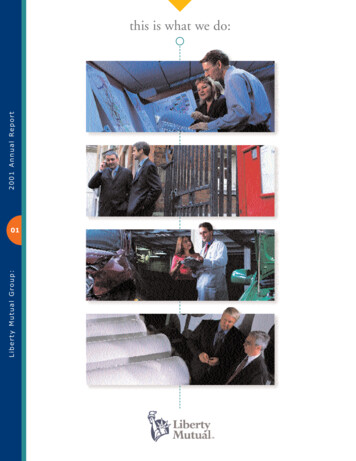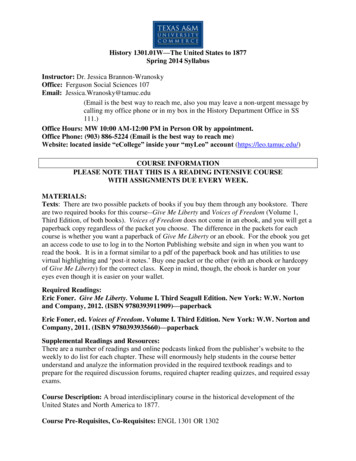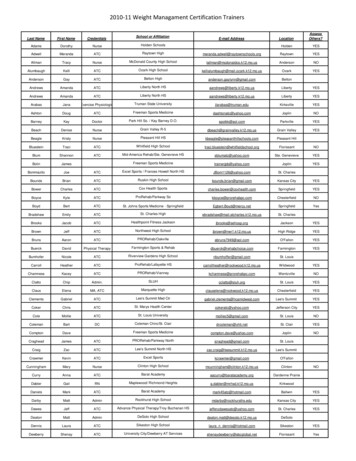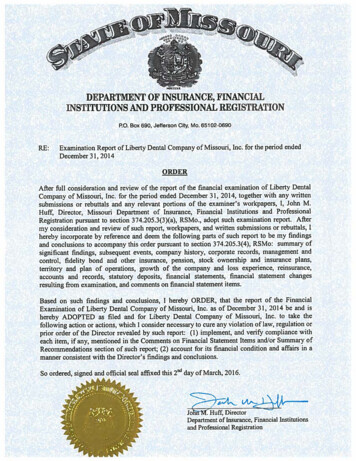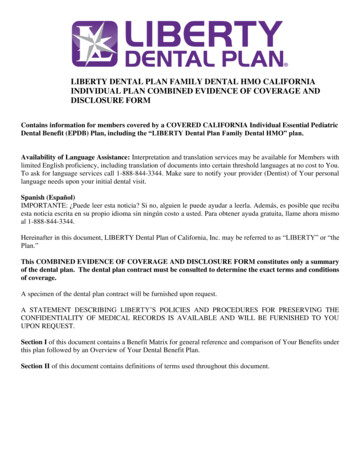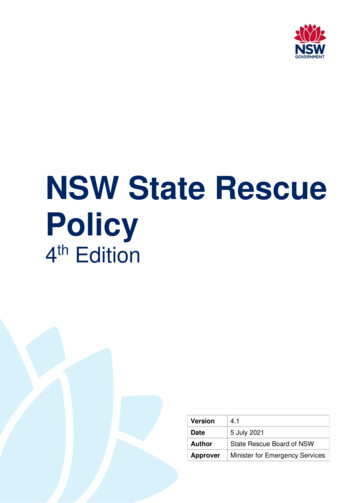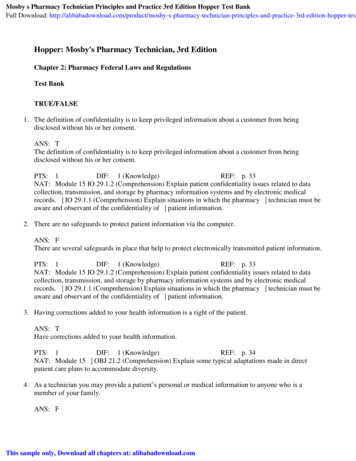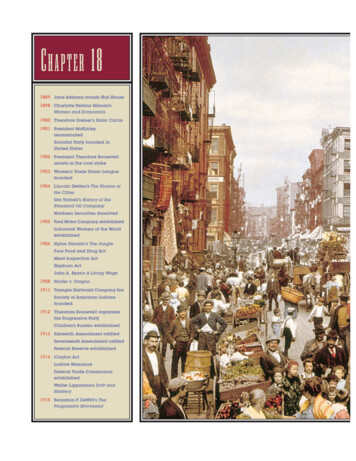
Transcription
C HAPTER 181889 Jane Addams founds Hull House1898 Charlotte Perkins Gilman’sWomen and Economics1900 Theodore Dreiser’s Sister Carrie1901 President McKinleyassassinatedSocialist Party founded inUnited States1902 President Theodore Rooseveltassists in the coal strike1903 Women’s Trade Union Leaguefounded1904 Lincoln Steffen’s The Shame ofthe CitiesIda Tarbell’s History of theStandard Oil CompanyNorthern Securities dissolved1905 Ford Motor Company establishedIndustrial Workers of the Worldestablished1906 Upton Sinclair’s The JunglePure Food and Drug ActMeat Inspection ActHepburn ActJohn A. Ryan’s A Living Wage1908 Muller v. Oregon1911 Triangle Shirtwaist Company fireSociety of American Indiansfounded1912 Theodore Roosevelt organizesthe Progressive PartyChildren’s Bureau established1913 Sixteenth Amendment ratifiedSeventeenth Amendment ratifiedFederal Reserve established1914 Clayton ActLudlow MassacreFederal Trade CommissionestablishedWalter Lippmann’s Drift andMastery1915 Benjamin P. DeWitt’s TheProgressive Movement
The Progressive Era,1900–1916AN URBAN AGE AND ACONSUMER SOCIETYTHE POLITICS OFPROGRESSIVISMFarms and CitiesThe MuckrakersImmigration as a GlobalProcessThe Immigrant Quest forFreedomConsumer FreedomThe Working WomanThe Rise of FordismThe Promise of AbundanceAn American Standard of LivingEffective FreedomState and Local ReformsProgressive DemocracyGovernment by ExpertJane Addams and Hull House“Spearheads for Reform”The Campaign for WomanSuffrageMaternalist ReformThe Idea of EconomicCitizenshipVARIETIES OFPROGRESSIVISMTHE PROGRESSIVEPRESIDENTSIndustrial FreedomThe Socialist PresenceThe Gospel of DebsAFL and IWWThe New Immigrants on StrikeLabor and Civil LibertiesThe New FeminismThe Rise of Personal FreedomThe Birth-Control MovementNative American ProgressivismTheodore RooseveltRoosevelt and EconomicRegulationThe Conservation MovementTaft in OfficeThe Election of 1912New Freedom and NewNationalismWilson’s First TermThe Expanding Role ofGovernmentA rare color photograph from around 1900 shows the teeming street life of MulberryStreet, on New York City’s densely populated Lower East Side. The massive immigrationof the early twentieth century transformed the life of urban centers throughout the countryand helped to spark the Progressive movement.
F OCUS Q UESTIONS Why was the city such acentral element in Progressive America? How did the labor andwomen’s movementschallenge the nineteenthcentury meanings ofAmerican freedom? In what ways did Progressivism include bothdemocratic and antidemocratic impulses? How did the Progressivepresidents foster the rise ofthe nation-state? lIt was late afternoon on March 25, 1911, when fire broke out at theTriangle Shirtwaist Company. The factory occupied the top threefloors of a ten-story building in the Greenwich Village neighborhoodof New York City. Here some 500 workers, mostly young Jewish andItalian immigrant women, toiled at sewing machines producingladies’ blouses, some earning as little as three dollars per week. Thosewho tried to escape the blaze discovered that the doors to the stairwellhad been locked—the owners’ way, it was later charged, of discouragingtheft and unauthorized bathroom breaks. The fire department rushed tothe scene with high-pressure hoses. But their ladders reached only to thesixth floor. As the fire raged, onlookers watched in horror as girls leaptfrom the upper stories. By the time the blaze had been put out, 46 bodieslay on the street and 100 more were found inside the building.The Triangle Shirtwaist Company was typical of manufacturing in thenation’s largest city, a beehive of industrial production in small, crowdedfactories. New York was home to 30,000 manufacturing establishmentswith more than 600,000 employees—more industrial workers than theentire state of Massachusetts. Triangle had already played a key role in theera’s labor history. When 200 of its workers tried to join the InternationalLadies’ Garment Workers Union (ILGWU), the owners responded byfiring them. This incident helped to spark a general walkout of femalegarment workers in 1909—the Uprising of the 20,000. Among the strikers’demands was better safety in clothing factories. The impoverishedimmigrants forged an alliance with middle- and upper-class femalesupporters, including members of the Women’s Trade Union League,which had been founded in 1903 to help bring women workers intounions. Alva Belmont, the ex-wife of railroad magnate WilliamVanderbilt, contributed several of her cars to a parade in support of thestriking workers. By the time the walkout ended early in 1911, theILGWU had won union contracts with more than 300 firms. But theTriangle Shirtwaist Company was not among them.The Triangle fire was not the worst fire disaster in American history(seven years earlier, over 1,000 people had died in a blaze on the GeneralSlocum excursion boat in New York Harbor). But it had an unrivaledimpact on public consciousness. More than twenty years later, Franklin D.Roosevelt would refer to it in a press conference as an example of why thegovernment needed to regulate industry. In its wake, efforts to organizethe city’s workers accelerated, and the state legislature passed new factoryinspection laws and fire safety codes.Triangle focused attention on the social divisions that plaguedAmerican society during the first two decades of the twentieth century,a period known as the Progressive era. These were years when economicexpansion produced millions of new jobs and brought an unprecedentedarray of goods within reach of American consumers. Cities expandedrapidly—by 1920, for the first time, more Americans lived in towns and
Why was the city such a central element in Progressive America?725Policemen stare up as the Triangle fire of1911 rages, while the bodies of factoryworkers who plunged to their deaths toescape the blaze lie on the sidewalk.cities than in rural areas. Yet severe inequality remained the most visiblefeature of the urban landscape, and persistent labor strife raised anew thequestion of government’s role in combating social inequality. The fire andits aftermath also highlighted how traditional gender roles were changingas women took on new responsibilities in the workplace and in themaking of public policy.The word “Progressive” came into common use around 1910 as a way ofdescribing a broad, loosely defined political movement of individuals andgroups who hoped to bring about significant change in American socialand political life. Progressives included forward-looking businessmenwho realized that workers must be accorded a voice in economic decisionmaking, and labor activists bent on empowering industrial workers.Other major contributors to Progressivism were members of femalereform organizations who hoped to protect women and children fromexploitation, social scientists who believed that academic research wouldhelp to solve social problems, and members of an anxious middle classwho feared that their status was threatened by the rise of big business.Everywhere in early-twentieth-century America the signs of economicand political consolidation were apparent—in the power of a smalldirectorate of Wall Street bankers and corporate executives, themanipulation of democracy by corrupt political machines, and the rise ofnew systems of managerial control in workplaces. In these circumstances,wrote Benjamin P. DeWitt, in his 1915 book The Progressive Movement, “theindividual could not hope to compete . . . . Slowly, Americans realizedthat they were not free.”As this and the following chapter will discuss, Progressive reformersresponded to the perception of declining freedom in varied, contradictoryways. The era saw the expansion of political and economic freedom
726Ch. 18 The Progressive Era, 1900–1916AN URBAN AGE ANDA CONSUMER SOCIETYthrough the reinvigoration of the movement for woman suffrage, the useof political power to expand workers’ rights, and efforts to improve democratic government by weakening the power of city bosses and giving ordinary citizens more influence on legislation. It witnessed the flowering ofunderstandings of freedom based on individual fulfillment and personalself-determination—the ability to participate fully in the ever-expandingconsumer marketplace and, especially for women, to enjoy economic andsexual freedoms long considered the province of men. At the same time,many Progressives supported efforts to limit the full enjoyment of freedom to those deemed fit to exercise it properly. The new system of whitesupremacy born in the 1890s became fully consolidated in the South.Growing numbers of native-born Americans demanded that immigrantsabandon their traditional cultures and become fully “Americanized.” Andefforts were made at the local and national levels to place political decision making in the hands of experts who did not have to answer to theelectorate. Even as the idea of freedom expanded, freedom’s boundariescontracted in Progressive America.City of Ambition, 1910, by thephotographer Alfred Stieglitz, capturesthe stark beauty of New York City’s newskyscrapers.AN URBAN AGE AND A CONSUMER SOCIETYFA R M SANDCITIESThe Progressive era was a period of explosive economic growth, fueled byincreasing industrial production, a rapid rise in population, and the continued expansion of the consumer marketplace. In the first decade of thetwentieth century, the economy’s total output rose by about 85 percent. Forthe last time in American history, farms and cities grew together. As farmprices recovered from their low point during the depression of the 1890s,American agriculture entered what would later be remembered as its “golden age.” The expansion of urban areas stimulated demand for farm goods.Farm families poured into the western Great Plains. More than 1 millionclaims for free government land were filed under theHomestead Act of 1862—more than in the previousTable 18.1 RISE OF THE CITY, 1880–1920forty years combined. Between 1900 and 1910, thecombined population of Texas and Oklahoma roseUrban PopulationNumber of Citiesby nearly 2 million people, and Kansas, Nebraska,Year(percentage)with 100,000! Populationand the Dakotas added 800,000. Irrigation trans188020%12formed the Imperial Valley of California and parts ofArizona into major areas of commercial farming.18902815But it was the city that became the focus of19003818Progressive politics and of a new mass-consumer soci19105021ety. Throughout the industrialized world, the number19206826of great cities multiplied. The United States countedtwenty-one cities whose population exceeded
Why was the city such a central element in Progressive America?100,000 in 1910, the largest of them NewYork, with 4.7 million residents. Thetwenty-three square miles of ManhattanIsland were home to over 2 million people, more than lived in thirty-three of thestates. Fully a quarter of them inhabitedthe Lower East Side, an immigrant neighborhood more densely populated thanBombay or Calcutta in India.The stark urban inequalities of the1890s continued into the Progressiveera. Immigrant families in New York’sdowntown tenements often had no electricity or indoor toilets. Three miles tothe north stood the mansions of FifthAvenue’s Millionaire’s Row. Accordingto one estimate, J. P. Morgan’s financialfirm directly or indirectly controlled 40percent of all financial and industrialcapital in the United States. Alongside such wealth, reported theCommission on Industrial Relations, established by Congress in 1912,more than one-third of the country’s mining and manufacturing workerslived in “actual poverty.”The city captured the imagination of artists, writers, and reformers. Theglories of the American landscape had been the focal point of nineteenthcentury painters (exemplified by the Hudson River school, which producedcanvases celebrating the wonders of nature). The city and its daily life now727The mansion of Cornelius Vanderbilt II onNew York City’s Fifth Avenue, in a 1920photograph. Designed in the style of aFrench château, it took up the entire block.Today, the Bergdorf Goodman departmentstore occupies the site.Six O’Clock, Winter, a 1912 painting byJohn Sloan, depicts a busy city street withan elevated railroad overhead. Sloan wasone of a group of painters dubbed theAshcan School because of their focus oneveryday city life.
728Ch. 18 The Progressive Era, 1900–1916AN URBAN AGE ANDA CONSUMER SOCIETYbecame their preoccupation. Painters like George W. Bellows and JohnSloan and photographers such as Alfred Stieglitz and Edward Steichen captured the electric lights, crowded bars and theaters, and soaring skyscrapers of the urban landscape. With its youthful, exuberant energies, the cityseemed an expression of modernity itself.THETwo photographs by Lewis Hine, whoused his camera to chronicle the plight ofchild laborers: a young spinner in asouthern cotton factory and “breaker” boyswho worked in a Pennsylvania coal mine.MUCKRAKERSOthers saw the city as a place where corporate greed undermined traditional American values. At a time when more than 2 million childrenunder the age of fifteen worked for wages, Lewis Hine photographed childlaborers to draw attention to persistent social inequality. A new generationof journalists writing for mass-circulation national magazines exposed theills of industrial and urban life. The Shame of the Cities by Lincoln Steffens(published as a series in McClure’s Magazine in 1901–1902 and in book formin 1904) showed how party bosses and business leaders profited from political corruption. McClure’s also hired Ida Tarbell to expose the arrogance andeconomic machinations of John D. Rockefeller’s Standard Oil Company.Published in two volumes in 1904, her History of the Standard Oil Companywas the most substantial product of what Theodore Roosevelt disparagedas “muckraking”—the use of journalistic skills to expose the underside ofAmerican life.Major novelists of the era took a similar unsparing approach to socialills. Theodore Dreiser’s Sister Carrie (1900) traced a hopeful young woman’sdescent into prostitution in Chicago’s harsh urban environment. Perhapsthe era’s most influential novel was Upton Sinclair’s The Jungle (1906),whose description of unsanitary slaughterhouses and the sale of rottenmeat stirred public outrage and led directly to the passage of the Pure Foodand Drug Act and the Meat Inspection Act of 1906.IMMIGRATIONASAGLOBALPROCESSIf one thing characterized early-twentieth-century cities, it was their immigrant character. The “new immigration” from southern and eastern Europe
729Why was the city such a central element in Progressive America?(discussed in Chapter 17) had begun around 1890 but reached its peak during the Progressive era. Between 1901 and the outbreak of World War I inEurope in 1914, some 13 million immigrants came to the United States, themajority from Italy, Russia, and the Austro-Hungarian empire. In fact,Progressive-era immigration formed part of a larger process of worldwidemigration set in motion by industrial expansion and the decline of traditional agriculture. Poles emigrated not only to Pittsburgh and Chicago butto work in German factories and Scottish mines. Italians sought jobs inBelgium, France, and Argentina as well as the United States. As many as750,000 Chinese migrated to other countries each year.During the years from 1840 to 1914 (when immigration to the UnitedStates would be virtually cut off, first by the outbreak of World War Iand then by legislation), perhaps 40 million persons emigrated to the UnitedStates and another 20 million to other parts of the Western Hemisphere,including Canada, Argentina, Brazil, and the Caribbean. This populationflow formed one part of a massive shifting of peoples throughout theworld, much of which took place in Asia. Millions of persons migrated toSoutheast Asia and the South Pacific, mainly from India and China.Millions more moved from Russia and northern Asia to Manchuria, Siberia,and Central Asia.THEWORLDONTHEMOVE,NorthSeaNORTH AMERICAAtl ant icOce anCANADAWinnipegHalifaxNew YorkMoscowMinskLvov6 million4 millioBakuSIBERIARUSSIAN EMPIRENovosibirsknsiaTashkentEAST ANDVladivostokSOUTHEASTASIA NANew OrleansthCalcutta BURMAAFRICAHong KongEGYPTMEXICOCUBABombay INDIAPuerto RicoVeracruzYEMENSIAMAcapulcoPac if icManilaDakarJAMAICABangkokSaigonNIGERIAOc ean14Accra LagosGeorgetownCaracasCeylon.5MALAYAPanama Canal (1914)UGANDADoualamiMogadishullioSingaporen inBelemterto AfricaDUTCH EAST ta)SOUTH AMERICACOASTMadagascar0.75 million toCallao LimaSalvadorAfrica and AustraliaBRAZILLa PazBeiraPa cifi cRio de JaneiroWindhoekMauritiusAUSTRALIABrisbaneOcea nSao PauloSOUTHMaputoAFRICAValparaisoIn dia n O c e anSydneyCapeTownMontevideoMelbourneBuenos AiresNEWARGENTINAZEALAND2.5 millionLos Angeles7 millionreturnees3 millionThe four world migration systems, 1815–1914:AtlanticRusso-SiberianAsian contract laborColonial8Estimated emigration (millions)Population, 1900:25 milllion peopleTransportation after 1880:Transcontinental railroadSuez Canal(1869)orom AChicagoEUROPElion35 milEUROPEANRUSSIA1815–1914ontllion fSeattleUNITEDSTATESSanFranciscoSt. LouisMIGRATION1millimiVancouverSt. Petersburg8million1WORLDThe century between 1815, when theNapoleonic Wars in Europe and the Warof 1812 in the United States ended, andthe outbreak of World War I in 1914,witnessed a series of massive shifts in theworld’s population. The 35 million peoplewho crossed the Atlantic to North Americaformed the largest migration stream, butmillions of migrants also moved to SouthAmerica, eastern Russia, and variousparts of Asia.Colonial plantation systems:Foods (wheat, rice, bananas)Stimulants (coffee, tea, tobacco, sugar, cocoa, opium)Industrial crops (cotton, palm oil, rubber)
730Ch. 18 The Progressive Era, 1900–1916An illustration in the 1912 publicationThe New Immigration depicts thevarious “types” entering the United States.Italian Family on Ferry Boat, LeavingEllis Island, a 1905 photograph by LewisHine. The family of immigrants has justpassed through the inspection process atthe gateway to the United States.AN URBAN AGE ANDA CONSUMER SOCIETYNumerous causes inspired this massive uprooting of population. Rural southern and eastern Europe and large partsof Asia were regions marked by widespread poverty and illiteracy, burdensome taxation, and declining economies.Political turmoil at home, like the revolution that engulfedMexico after 1911, also inspired emigration. Not all of theseimmigrants could be classified as “free laborers,” however.Large numbers of Chinese, Mexican, and Italian migrants,including many who came to the United States, were boundto long-term labor contracts. These contracts were signedwith labor agents, who then provided the workers toAmerican employers. But all the areas attracting immigrantswere frontiers of one kind or another—agricultural, mining,or industrial—with expanding job opportunities.Most European immigrants to the United States enteredthrough Ellis Island. Located in New York Harbor, thisbecame in 1892 the nation’s main facility for processingimmigrants. Millions of Americans today trace their ancestry to an immigrant who passed through Ellis Island. Theless fortunate, who failed a medical examination or werejudged to be anarchists, prostitutes, or in other ways undesirable, were sent home.At the same time, an influx of Asian and Mexican newcomers was taking place in the West. After the exclusion ofimmigrants from China in the late nineteenth century, a small number ofJapanese arrived, primarily to work as agricultural laborers in California’sfruit and vegetable fields and on Hawaii’s sugar plantations. By 1910, thepopulation of Japanese origin had grown to 72,000. Between 1910 and 1940,Angel Island in San Francisco Bay—the “Ellis Island of the West”—servedas the main entry point for immigrants from Asia.Far larger was Mexican immigration. Between 1900 and 1930, some1 million Mexicans (more than 10 percent of that country’s population)
731Why was the city such a central element in Progressive America?entered the United States—a number exceeded by only a few Europeancountries. Many Mexicans entered through El Paso, Texas, the main southern gateway into the United States. Many ended up in the San GabrielValley of California, where citrus growers searching for cheap labor hadearlier experimented with Native American, South Asian, Chinese, andFilipino migrant workers.By 1910, one-seventh of the American population was foreign-born, thehighest percentage in the country’s history. More than 40 percent of NewYork City’s population had been born abroad. In Chicago and smallerindustrial cities like Providence, Milwaukee, and San Francisco, the figureexceeded 30 percent. Although many newcomers moved west to take partin the expansion of farming, most clustered in industrial centers. By 1910,nearly three-fifths of the workers in the twenty leading manufacturing andmining industries were foreign-born.THEIMMIGRANTQUESTFORFREEDOMLike their nineteenth-century predecessors, the new immigrants arrivedimagining the United States as a land of freedom, where all persons enjoyedequality before the law, could worship as they pleased, enjoyed economicopportunity, and had been emancipated from the oppressive social hierarchies of their homelands. “America is a free country,” one Polish immigrantwrote home. “You don’t have to be a serf to anyone.” Agents sent abroad bythe American government to investigate the reasons forlarge-scale immigration reported that the main impetuswas a desire to share in the “freedom and prosperityenjoyed by the people of the United States.” Freedom,they added, was largely an economic ambition—a desireto escape from “hopeless poverty” and achieve a standardof living impossible at home. While some of the newimmigrants, especially Jews fleeing religious persecutionin the Russian empire, thought of themselves as permanent emigrants, the majority initially planned to earnenough money to return home and purchase land.Groups like Mexicans and Italians included many “birdsof passage,” who remained only temporarily in theUnited States. In 1908, a year of economic downturn inthe United States, more Italians left the country thanentered.The new immigrants clustered in close-knit “ethnic”neighborhoods with their own shops, theaters, and community organizations, and often continued to speak theirnative tongues. As early as 1900, more than 1,000 foreignlanguage newspapers were published in the UnitedA community settlement map for Chicago in 1900illustrates the immigrant and racialneighborhoods in the nation’s second largest city.Table 18.2 IMMIGRANTSAND THEIR CHILDREN ASPERCENTAGE OF POPULATION,TEN MAJOR CITIES, 1920CityPercentageNew York City76%Cleveland72Boston72Chicago71Detroit65San Francisco64Minneapolis63Pittsburgh59Seattle55Los Angeles45
732Ch. 18 The Progressive Era, 1900–1916An immigrant from Mexico, arrivingaround 1912 in a cart drawn by a donkey.AN URBAN AGE ANDA CONSUMER SOCIETYStates. Churches were pillars of these immigrant communities. In New York’s EastHarlem, even anti-clerical Italian immigrants,who resented the close alliance in Italybetween the Catholic Church and the oppressive state, participated eagerly in the annualfestival of the Madonna of Mt. Carmel. AfterItalian-Americans scattered to the suburbs,they continued to return each year to reenactthe festival.Although most immigrants earned morethan was possible in the impoverishedregions from which they came, they enduredlow wages, long hours, and dangerous working conditions. In the mines and factories ofPennsylvania and the Midwest, easternEuropean immigrants performed low-wageunskilled labor, while native-born workersdominated skilled and supervisory jobs. The vast majority of Mexicanimmigrants became poorly paid agricultural, mine, and railroad laborers,with little prospect of upward economic mobility. “My people are not inAmerica,” remarked one Slavic priest, “they are under it.”CONSUMERFREEDOMCities, however, were also the birthplace of a mass-consumption societythat added new meaning to American freedom. There was, of course, nothing unusual in the idea that the promise of American life lay, in part, in theenjoyment by the masses of citizens of goods available in other countriesonly to the well-to-do. Not until the Progressive era, however, did theadvent of large downtown department stores, chain stores in urban neighborhoods, and retail mail-order houses for farmers and small-town resi-In Hester Street, painted in 1905, GeorgeLuks, a member of the Ashcan School ofurban artists, captures the colorful streetlife of an immigrant neighborhood in NewYork City.
!VISIONS OF FREEDOMMovie, 5 Cents. In this 1907 painting, the artist JohnSloan depicts the interior of a movie house. By this time,millions of people each week were flocking to see silentmotion pictures. The audience includes different classesand races, as well as couples and women attendingalone.QUESTIONS1. What does the nature of the audience suggest about movie theaters as places of a newsocial freedom?2. Does the painting help explain why somecritics complained that movies promotedimmorality?733
734Ch. 18 The Progressive Era, 1900–1916Women at work in a shoe factory, 1908.AN URBAN AGE ANDA CONSUMER SOCIETYdents make available to consumers throughout the country the vast arrayof goods now pouring from the nation’s factories. By 1910, Americans couldpurchase, among many other items, electric sewing machines, washingmachines, vacuum cleaners, and record players. Low wages, the unequaldistribution of income, and the South’s persistent poverty limited the consumer economy, which would not fully come into its own until after WorldWar II. But it was in Progressive America that the promise of mass consumption became the foundation for a new understanding of freedom asaccess to the cornucopia of goods made available by modern capitalism.Leisure activities also took on the characteristics of mass consumption.Amusement parks, dance halls, and theaters attracted large crowds of citydwellers. The most popular form of mass entertainment at the turn of thecentury was vaudeville, a live theatrical entertainment consisting ofnumerous short acts typically including song and dance, comedy, acrobats,magicians, and trained animals. In the 1890s, brief motion pictures werealready being introduced into vaudeville shows. As the movies becamelonger and involved more sophisticated plot narratives, separate theatersdeveloped. By 1910, 25 million Americans per week, mostly working-classurban residents, were attending “nickelodeons”—motion-picture theaterswhose five-cent admission charge was far lower than at vaudeville shows.THEWORKINGWOMANThe new visibility of women in urban public places—at work, as shoppers,and in places of entertainment like cinemas and dance halls—indicatedthat traditional gender roles were changing dramatically in ProgressiveAmerica. As the Triangle fire revealed, more and more women were working for wages. Black women still worked primarily as domestics or insouthern cotton fields. Immigrant women were largely confined to lowpaying factory employment. But for native-born white women, the kindsof jobs available expanded enormously. By 1920, around 25 percent ofemployed women were office workers or telephone operators, and only15 percent worked in domestic service, the largest female job category ofthe nineteenth century. Female work was no longer confined to young,unmarried white women and adult black women. In 1920, of 8 millionwomen working for wages, one-quarter were married and living with theirhusbands.Table 18.3 PERCENTAGE OF WOMEN 14 YEARS AND OLDER INTHE LABOR FORCEYearAllWomenMarriedWomenWomen as %of Labor 2424.311.725
735Why was the city such a central element in Progressive America?The working woman—immigrant and native, working-class andprofessional—became a symbol of female emancipation. Women faced special limitations on their economic freedom, including wage discriminationand exclusion from many jobs. Yet almost in spite of themselves, unionleader Abraham Bisno remarked, young immigrant working women developed a sense of independence: “They acquired the right to a personality,” something alien to the highly patriarchal family structures of the old country. “Weenjoy our independence and freedom” was the assertive statement of theBachelor Girls Social Club, a group of female mail-order clerks in New York.The growing number of younger women who desired a lifelong career,wrote Charlotte Perkins Gilman in her influential book Women andEconomics (1898), offered evidence of a “spirit of personal independence”that pointed to a coming transformation of both economic and family life.Gilman’s writings reinforced the claim that the road to woman’s freedomlay through the workplace. In the home, she argued, women experiencednot fulfillment but oppression, and the housewife was an unproductiveparasite, little more than a servant to her husband and children. By condemning women to a life of domestic drudgery, prevailing gender normsmade them incapable of contributing to society or enjoying freedom in anymeaningful sense of the word.The desire to participate in the consumer society produced remarkablysimilar battles within immigrant families of all nationalities between parents and their self-consciously “free” children, especially daughters. Contemporaries, native and immigrant, noted how “the novelties and frivolitiesof fashion” appealed to young working women, who spent part of their meager wages on clothing and makeup and at places of entertainment.Daughters considered parents who tried to impose curfews or to preventthem from going out alone to dances or movies as old-fashioned and not sufficiently “American.” Immigrant parents
1889 Jane Addams founds Hull House 1898 Charlotte Perkins Gilman's Women and Economics 1900 Theodore Dreiser's Sister Carrie 1901 President McKinley assassinated Socialist Party founded in United States 1902 President Theodore Roosevelt assists in the coal strike 1903 Women's Trade Union League founded 1904 Lincoln Steffen's The Shame of the Cities
